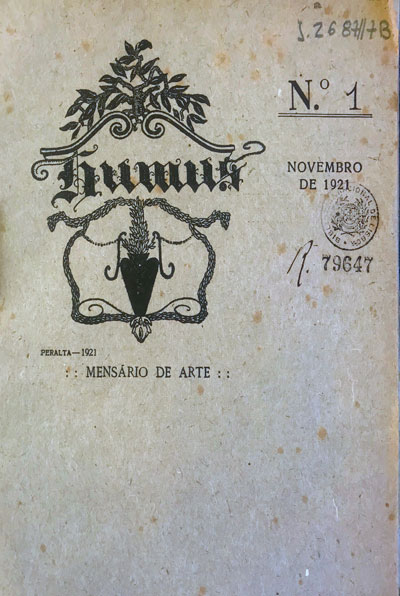
"Mensário de Arte" (Art Monthly) is composed and printed at the A Tribuna Press, in Porto. The magazine always opens with an unpublished, handwritten poem, similar to what happens in Folhas de Arte (1924). In the first issue the poem is by António Feijó ("Árvores Secas” / “Dry Trees"), sent by a family member Colonel Júlio Feijó and in nº2 the poem is "Exílio", by Júlio Brandão.
As a director, Celestino Gomes is a constant presence also as an author in all issues, a very common rule in this type of magazine. Visconde de Villa-Moura (Bento de Oliveira Cardoso and Castro Guedes de Carvalho Lobo) is another very assiduous contributor to this magazine, being the poet who opens, with manuscript, number 3. A passage from his unpublished poem says a lot about the purpose of this art magazine: "The most beautiful manifestation of life is Art. The most beautiful of the arts is sculpture. The greatest of sculptors is time. The most beautifully sculptured work of our time is doom."
Precisely, in the second issue, Aarão de Lacerda has a long article about the sculptor Diogo de Macedo, followed by an extra-text with a bust of his authorship; an article that continues to the next issue. Perhaps, given the interest of this article, it is worth taking a moment here. Lacerda is quick to mention that Macedo would be a natural follower of Soares dos Reis. After a brief biography, the writer tells how he met him and what he saw the artista in his studio. What matters fundamentally in this article is all the strength that Lacerda imprints on betting on the future career, which we know today, would be dazzling, of the Portuguese sculptor. That's what it says here: "Diogo is young: he is, it seems to me, thirty-one. His life as an artist is still brief, with plenty of time before him to create and sculpt his marbles."
This is an “Art Monthly”, and the art does seem to be quite pervasive in the content. Here, the role of the graphic artist João Carlos (1899-1960), who signs multiple vignettes of the magazine, namely the incipits of the initial letter, should be highlighted. He is a young illustrator whose career begins in the 1920s with the illustration of books by some of the authors in the magazine (Celestino Gomes, Thibaldina Mota), namely António Pereira Cardoso, whom he caricatures in a successful drawing in number 2. Other artistic contributions worth noting is precisely the section "Os Novos" (“The young”), where this and other caricatures of ‘young’ authors, are then balanced with extratexts from illustrious artists such as António Carneiro (nº3).
Among the varied literary collaborations (from the ill-fated Trás-os-Montes poet Carlos Cochofel, to Narciso de Azevedo, through to the Galician collaboration Euxénio Carré Alvallelos), it is worth highlighting a poem by Hernâni Cidade in nº 3 (a sonnet focusing on medieval chivalry, in a Symbolist grammar language), dating from the time when Cidade was already a professor at the Faculty of Letters of Porto, after being part of the expeditionary corps in the first world war.
In the final issue (4) in February 1922, where João Penha is the poet with the right to a manuscript ("A um poeta d'agua doce"), there is an interesting translation by António Ferreira (1885-1963) of a poem by Alfredo de Musset, "Jamais" (1839). Also in this final issue, a Luso-Hebrew note should be highlighted: collaboration of Captain Barros Basto (1887-1961), signing with his Hebrew name Abraham Ben-Rosh, a four-part short story devoted to "Shabbath", its title. Additionally, we have the indication that this tale will be included in the 'book in preparation' Sepharadim (the Luso-Hebrews), which ended up never being published. It is a surprising presence in a northern art monthly that lasted only 4 issues.
Ricardo Marques
